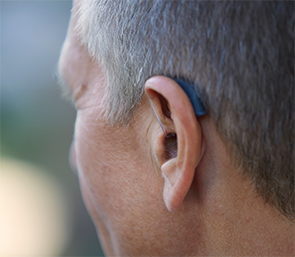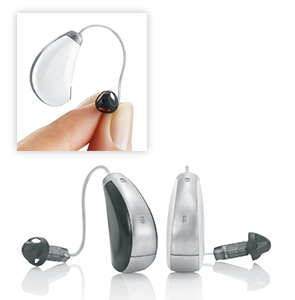
The behind-the-ear ReSound LiNX2 is designed to be discreet.
Image Credit: Courtesy of GN ReSound.
The next time you see someone tapping and sliding their fingers across their smartphone screen, they might not be texting or surfing. They might be improving their hearing.
Explore This Issue
September 2015New hearing aids introduced last year that are adjustable, smarter, and more nimble with the use of a smartphone app have given the hearing impaired much more control over their listening environments and have helped shed the stigma associated with having to reach up to their ears to adjust the device.
The Devices
The ReSound LiNX2, manufactured by GN ReSound (Bloomington, Minn.), and the Halo, made by Starkey Hearing Technologies (Eden Prairie, Minn.), were introduced almost simultaneously in early 2014, and they remain the only two players in the market, although the devices sometimes go by other names. The Beltone First is made by the same manufacturer as the LiNX2, and the Halo is also marketed as the Audibel A3i, Audigy AGXsp, MicroTech Kinnect, and the NuEar iSDS.
Using a low-energy Bluetooth signal, the devices allow users to adjust the left and right volumes and the bass and treble using an app on their smart phones (ReSound Smart for the LiNX2 and TruLink for the Halo). Users can also stream music and video sound from their phones directly to the device. They can use their phones to better “target” the area they’re trying to hear and store settings for specific locations that can be automatically recalled using the phone’s GPS system.
Both are compatible with iPhone and iPad, as well as Android products, but music and video sound cannot be streamed directly to the hearing aid on Android smartphones due to differences between Apple and Android technology. They also both work with the Apple Watch, but only to use certain key features.
TruLink includes a feature called SoundSpace that allows users to more easily make adjustments to combinations of loudness, softness, bass, and treble by sliding a fingertip across a field, rather than adjusting each setting individually. Halo also includes a car mode that senses when a user is traveling faster than 10 mph and switches to settings that allow for easier listening in the difficult environment of an automobile.

The behind-the-ear version of the made-for-iPhone Starkey Halo hearing aid.
Courtesy Starkey Hearing Technologies
The ReSound Smart app includes spatial sense, in which the hearing aids communicate with each other to help improve spatial awareness, directionality in hearing, and speech understanding.